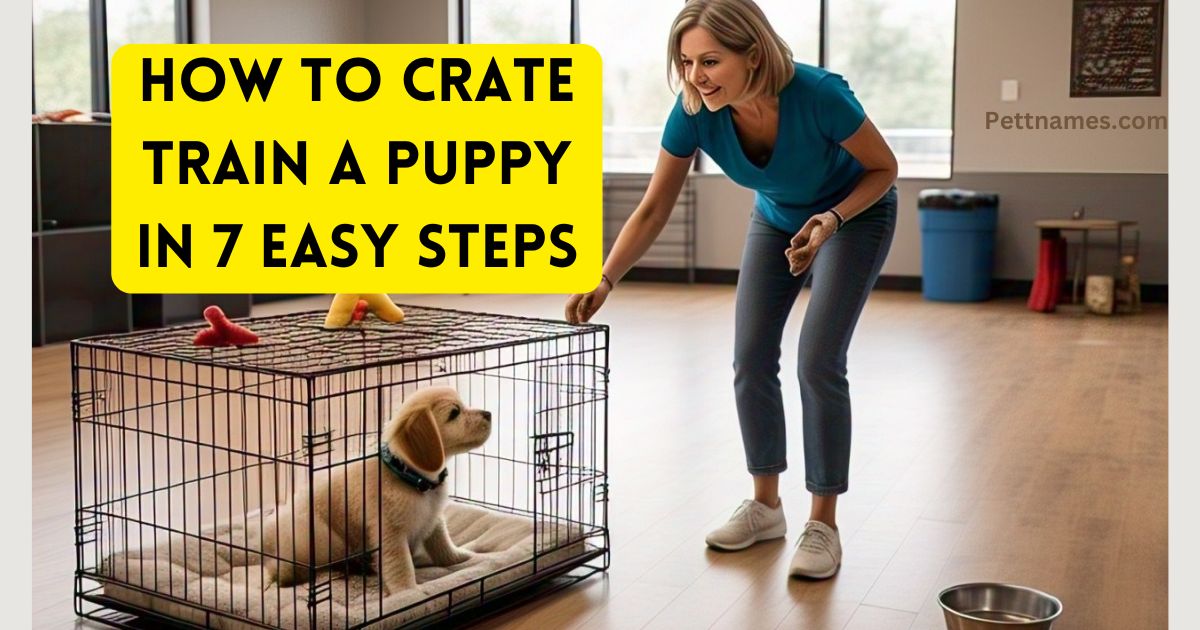Bringing home a new puppy is an exciting experience, but crate training can feel overwhelming for first-time pet parents. Don’t worry—we’ve got you covered!Crate training is one of the best ways to ensure your puppy feels safe, learns good behavior, and becomes housebroken. In this guide, we’ll walk you through how to crate train a puppy in 7 easy steps, designed especially for new owners. By the end, you’ll have a happy, well-trained pup. Let’s get started!

Why Crate Training is Important for Your Puppy
Crate training isn’t just about confining your puppy—it’s about creating a safe, comfortable space they can call their own. Here’s why it’s essential:
Benefits of Crate Training
- Safe Space: A crate becomes your puppy’s den, where they can retreat and feel secure.
- Housebreaking: Puppies naturally avoid soiling their sleeping area, making crate training a great tool for potty training.
- Behavior Management: Crates help prevent destructive behavior when you’re not around.
Common Misconceptions About Crate Training
- “Crates are cages”: Not true! When used correctly, crates are cozy, safe spaces for your pup.
- “It’s cruel”: Crate training, when done right, reduces anxiety and helps your puppy feel secure.
![]()
How to Crate Train a Puppy in 7 Easy Steps
Follow these simple, stress-free steps to crate train your puppy successfully:
Step 1: Choose the Right Crate
- Types of Crates: Wire, plastic, or soft-sided crates—choose one that suits your puppy’s size and needs.
- Sizing Tips: The crate should be big enough for your puppy to stand, turn around, and lie down comfortably.
- Pro Tip: Use a divider for larger crates to make the space cozier as your puppy grows.
Step 2: Introduce the Crate Gradually
- Place the crate in a quiet, accessible area of your home.
- Add soft bedding, toys, and treats to make it inviting.
- Let your puppy explore the crate at their own pace—never force them inside.
Step 3: Create a Positive Association
- Use treats, praise, and toys to encourage your puppy to enter the crate willingly.
- Feed meals near or inside the crate to build a positive connection.
- Keyword Tip: “Make a puppy love their crate” by associating it with good things.
Step 4: Start with Short Sessions
- Begin by closing the crate door for a few minutes while you’re nearby.
- Gradually increase the time as your puppy becomes more comfortable.
- Pro Tip: Use a crate training schedule to maintain consistency.
Step 5: Use the Crate for Meals and Nap Times
- Incorporate the crate into your puppy’s daily routine.
- Feed meals inside the crate and encourage naps there to reinforce its use.
- Keyword Tip: “Crate train a puppy during the day” by making it part of their routine.
Step 6: Handle Nighttime Crate Training
- Place the crate near your bed initially to reduce separation anxiety.
- Use a soft blanket or toy to comfort your puppy at night.
- Keyword Tip: “How to crate train a puppy at night” by creating a calming environment.
Step 7: Be Patient and Consistent
- Crate training takes time—patience is key.
- Stick to a routine and reward good behavior to reinforce positive habits.
- Keyword Tip: “Crate train a puppy without stress” by staying calm and consistent.
![]()
Common Challenges and Solutions
What to Do If Your Puppy Cries in the Crate
- Avoid letting them out immediately—this reinforces crying.
- Use calming techniques like a soft toy or white noise machine.
- Keyword Tip: “Stop puppy from crying in crate” by addressing the root cause.
How to Crate Train a Stubborn Puppy
- Use high-value treats and toys to motivate your puppy.
- Break training into smaller, manageable steps.
- Keyword Tip: “Crate training tips for stubborn puppies” to overcome resistance.
you may also like:
Top 50 Cute and Popular Pet Names for Male and Female Puppies in 2025
Tips for Success in Crate Training
Avoid These Crate Training Mistakes
- Using the crate as punishment: This creates negative associations.
- Leaving your puppy too long: Puppies need frequent breaks for potty and play.
Tools and Accessories to Make Crate Training Easier
- Crate mats: For comfort and durability.
- Chew toys: To keep your puppy entertained.
- Calming sprays: To reduce anxiety and create a relaxing environment.
Bonus Tips: Solving Common Puppy Training Challenges
Bringing home a new puppy is an exciting adventure, but it comes with its fair share of challenges—especially when it comes to training. From crate training at night to teaching your puppy not to bite or pee inside, this guide covers everything you need to know to raise a well-behaved, happy pup. Let’s dive in!
![]()
How to Crate Train a Puppy at Night
Crate training at night can be a game-changer for both you and your puppy. Here’s how to do it right:
- Choose the Right Crate Location
- Place the crate in your bedroom initially to help your puppy feel secure.
- Gradually move it to its permanent location over time.
- Make the Crate Comfortable
- Add soft bedding, a cozy blanket, and a favorite toy.
- Use a crate cover to create a den-like environment.
- Establish a Bedtime Routine
- Take your puppy out for a potty break right before bed.
- Use a calming phrase like “time for bed” to signal it’s crate time.
- Handle Nighttime Whining
- If your puppy cries, wait a few minutes before responding to avoid reinforcing the behavior.
- Take them out for a quick potty break if needed, but keep interactions calm and minimal.
- Be Consistent
- Stick to the same routine every night to help your puppy adjust.
Pro Tip: Use a white noise machine or soft music to soothe your puppy and drown out household noises.
How to Train a Puppy to Pee Outside
Housebreaking your puppy is one of the most important steps in training. Here’s how to teach your puppy to pee outside:
- Establish a Potty Schedule
- Take your puppy outside first thing in the morning, after meals, after naps, and before bed.
- Puppies typically need to go every 1-2 hours.
- Choose a Designated Potty Spot
- Pick a specific area in your yard and always take your puppy there.
- Use a consistent command like “go potty” to reinforce the behavior.
- Reward Success
- Praise your puppy enthusiastically and offer a treat immediately after they pee outside.
- Positive reinforcement is key to success.
- Watch for Signs
- If your puppy starts sniffing, circling, or whining, take them outside immediately.
- Clean Accidents Thoroughly
- Use an enzymatic cleaner to remove odors and prevent repeat accidents.
Pro Tip: Be patient—housebreaking can take several weeks or even months.
How to Train a Puppy Not to Bite You
Puppies explore the world with their mouths, but it’s important to teach them bite inhibition early. Here’s how:
- Redirect with Toys
- When your puppy bites, offer a chew toy instead.
- This teaches them what’s appropriate to bite.
- Use a Firm “No”
- Say “no” in a calm, firm voice when your puppy bites.
- Stop playing immediately to show that biting ends fun.
- Teach Bite Inhibition
- If your puppy bites too hard, let out a high-pitched yelp to mimic how another puppy would react.
- This helps them learn to control their bite strength.
- Reward Gentle Behavior
- Praise and reward your puppy when they play gently without biting.
- Provide Plenty of Exercise
- A tired puppy is less likely to bite out of boredom or excess energy.
Pro Tip: Avoid rough play that encourages biting, like wrestling or tug-of-war.
![]()
How to Train a Puppy Not to Pee Inside
Accidents happen, but with consistency, you can teach your puppy to avoid peeing inside. Here’s how:
- Stick to a Routine
- Take your puppy outside frequently, especially after meals, naps, and playtime.
- Use Positive Reinforcement
- Reward your puppy with treats and praise every time they pee outside.
- Supervise Indoors
- Keep your puppy in sight or confined to a small area when indoors.
- Use baby gates or a playpen to limit their access.
- Interrupt Accidents
- If you catch your puppy peeing inside, clap your hands or say “no” to interrupt them.
- Immediately take them outside to finish.
- Clean Accidents Thoroughly
- Use an enzymatic cleaner to remove odors and prevent repeat accidents.
Pro Tip: Avoid punishing your puppy for accidents—it can create fear and confusion.
you may also like:
Top 5 AI Tools for Pet Anxiety Relief in 2025: A Guide for Pet Owners
Conclusion: How to Crate Train a Puppy
Crate training your puppy doesn’t have to be stressful. By following these 7 easy steps, you’ll create a safe, happy space for your furry friend while teaching them good habits. Remember, patience and consistency are your best tools. Start crate training today, and enjoy the benefits of a well-behaved, confident puppy!
Final CTA
Ready to start crate training? Follow this guide and share your success stories in the comments below! Don’t forget to subscribe for more pet care tips and tricks.
Frequently Asked Questions (FAQs): How to Crate Train a Puppy
Crate training is one of the most effective ways to help your puppy feel safe, learn good behavior, and become housebroken. However, new puppy owners often have questions about the process. Below, we’ve answered the top 5 most common questions about crate training to help you get started with confidence.
1. How Long Does It Take to Crate Train a Puppy?
Answer:
The time it takes to crate train a puppy varies depending on their age, temperament, and consistency in training. On average, most puppies adapt to crate training within 2-4 weeks. However, some puppies may take longer, especially if they’re particularly anxious or stubborn.
Tips for Success:
- Be patient and consistent with your training routine.
- Use positive reinforcement, like treats and praise, to encourage your puppy.
- Gradually increase crate time to avoid overwhelming your puppy.
2. What Size Crate Should I Get for My Puppy?
Answer:
The crate should be just big enough for your puppy to stand up, turn around, and lie down comfortably. If the crate is too large, your puppy may use one corner as a bathroom, which can hinder housebreaking.
Tips for Choosing the Right Crate:
- Use a divider panel for larger crates to adjust the space as your puppy grows.
- For small breeds, consider a crate that will fit their adult size.
- For larger breeds, choose a crate that accommodates their expected adult size but use a divider during puppyhood.
3. How Do I Stop My Puppy from Crying in the Crate at Night?
Answer:
Nighttime crying is common, but there are ways to reduce it:
- Place the Crate Near Your Bed: This helps your puppy feel secure and reduces separation anxiety.
- Create a Calm Environment: Use a soft blanket, a favorite toy, or a white noise machine to soothe your puppy.
- Establish a Bedtime Routine: Take your puppy out for a potty break right before bed and use a calming phrase like “time for bed.”
- Avoid Reinforcing Crying: Wait a few minutes before responding to cries, and take your puppy out only if they need to potty.
Pro Tip: Be consistent—your puppy will eventually learn that nighttime is for sleeping, not crying.
4. Can I Crate Train an Older Dog, or Is It Only for Puppies?
Answer:
Yes, you can absolutely crate train an older dog! While it may take a bit more time and patience, older dogs can learn to love their crate just like puppies.
Tips for Crate Training an Older Dog:
- Introduce the crate gradually and make it a positive experience with treats and praise.
- Use high-value rewards, like their favorite treats or toys, to encourage them to enter the crate.
- Be patient and avoid forcing your dog into the crate, as this can create negative associations.
5. How Often Should I Take My Puppy Out of the Crate During the Day?
Answer:
Puppies have small bladders and need frequent breaks. A general rule of thumb is to take your puppy out:
- Every 1-2 hours during the day.
- Immediately after waking up, eating, drinking, or playing.
- Right before bedtime and first thing in the morning.
Tips for Managing Crate Time:
- Use a crate training schedule to maintain consistency.
- Gradually increase crate time as your puppy gets older and can hold their bladder longer.
- Always reward your puppy for going potty outside to reinforce good behavior.
Crate training is a valuable tool for raising a well-behaved, happy puppy. By addressing these common questions, you’ll be better equipped to handle the challenges and enjoy the rewards of crate training. Remember, patience and consistency are key!
CTA
Have more questions about crate training or How to Crate Train a Puppy? Leave a comment below, and don’t forget to subscribe for more puppy training tips and advice!
for more posts please visit at pettnames.com
read also:



